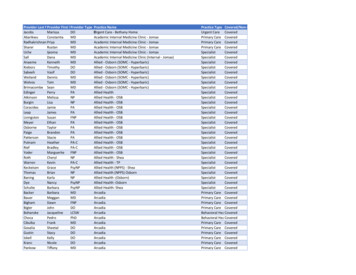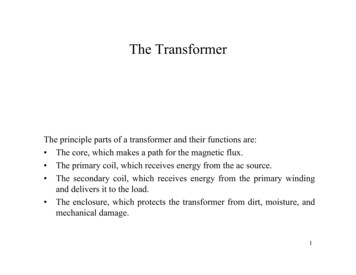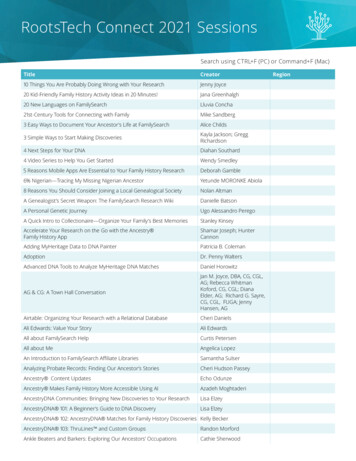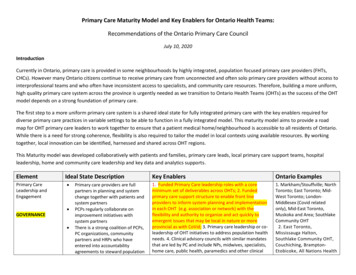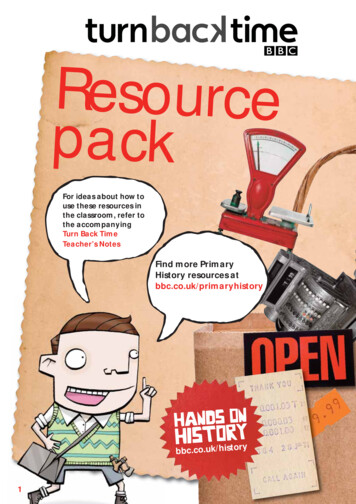
Transcription
ResourcepackFor ideas about how touse these resources inthe classroom, refer tothe accompanyingTurn Back TimeTeacher’s NotesFind more PrimaryHistory resources atbbc.co.uk/primaryhistorybbc.co.uk/history1
Activity 1 Types of shopCut out the shop signs and use them in a classroom activityabout high streets from the past.UNITEDDAIRY SHOPBUTCHERest 1868Record s h o pbbc.co.uk/history2
Activity 1SWEET SHOPhaberdashersybbc.co.uk/histor3
Activity 1FISHMONGERSEST 1906Post OfficeGREENGROCERybbc.co.uk/histor4
Activity 1GrocersNewsAgent sybbc.co.uk/histor5
Activity 1established 1867blacksmithlJewellerslEST 1906CHEMISTybbc.co.uk/histor6
Activity 1WordsearchHow many words can you find? Cross them off the listas you uncover them. Be careful – one doesn’t appearin the puzzle, but which one could it be?BlacksmithRecord shopSupermarketScalesDelivery GIONZFNMGRAMYNDNMDCTICZEAGBOFQNOHZTSOFUH
Activity 2 The shop frontDesign your own shop advertThink about including:know The name of your shop – choose one youor make up your own!there – this should A picture of the shop or the items solde it bright and colourful.maksomake people want to buy things, The location of the shop – so people knowwhere to find you.ybbc.co.uk/histor8
Activity 3 Going shoppingHistoric Shopping lists 1900 to 1975Split the class into groups or pairs and hand each a historical shoppinglist. Each group needs to work out what they can afford to buy.A Shopping list from around 1900The value of money: 240 pennies make up an old pound.(pennies were written as d) 12 pennies equal 1 shilling shown as 1sYou have to decide what you would buy to help yourfamily eat a healthy diet.You have 3d to spend.Work out what you could afford to buy.I letter to post - 1d3dThe Times Newspaper I pint of milk - 2dd1 Dozen eggs - 1 and ½Your shopping list andwhat each item costs:A Shopping list from around 1914The value of money: 240 pennies make up an old pound.(pennies were written as d) 12 pennies equal 1 shilling shown as 1sYou have to decide what you would buy to helpyour family eat a healthy diet.You have 4d to spend.Work out what you could afford to buy.Pint of Milk - 1d1/2 dozen medium sized eggs - 3d¼ lb of loose tea - 2dLoaf of bread - 1dbbc.co.uk/history9
Activity 3A Shopping list from around 1940The value of money: 240 pennies make up an old pound.(pennies were written as d) 12 pennies equal 1 shilling shown as 1sYou have to decide what you would buy to helpyour family eat a healthy diet.You have a shilling to spend. You must rememberthat everything is rationed due to World War Twoand eggs and chocolate are very scare so thesemay only be available on the black market.Work out what you could afford to buy.Your shopping list andwhat each item costs:I PINT OF MILK - 2D1 TIN OF BEANS – 7DDOZEN EGGS – 1S 6DMARS BAR – 6DYour shopping list andwhat each item costs:A Shopping list from around 1950The value of money: 240 pennies make up an old pound.(pennies were written as d) 12 pennies equal 1 shilling shown as 1sYou have to decide what you would buy to helpyour family eat a healthy diet.You have 1 shilling to spend.Work out what you could afford to buy.A Shopping list from around 1975The value of money: In 1971 Britain moves to the decimalisationsystem and have the same system as today.100 pennies 1.You have to decide what you would buy to helpyour family eat a healthy diet.You have 1 to spend.Work out what you could afford to buy.Pint of Milk 2dLoaf of bread 2d1/2 dozen Eggs 3dBag of sugar 5dYour shopping list andwhat each item costs:1 pint of milk 7pLoaf of bread 16p6 eggs 21pCheese 1.26pybbc.co.uk/histor10
Activity 4 The High StreetIn groups or pairs, ask your students to research oneof the six time periods below featured in the BBC 1series Turn Back Time. In particular, ask them tofind old photographs or drawings of high streetsfrom the time period.Victorian eraThe Victorian era saw the creation of the high street as we know it today.As more people moved into the cities, fewer were able to grow their ownproduce and began to rely on shops for food and other goods. Meat andvegetables were displayed for all to see outside the shops, so the early highstreet looked more like what we would now call a market. The buildings hadsmall windows to help keep the contents cool and some would have hadworkrooms for making the products on sale. Victorian photos are extremelyrare, but sketches and cartoons may be found.Edwardian eraIn the Edwardian era shopping became a pastime in itself. Cheap imports meanteven the poorest people were able to afford meat on occasion and canned goodswere becoming more popular. Selfridges opened in 1909, bringing luxury to thepeople as never before. The start of the First World War in 1914 shattered thecomforts of the early 1900s and food prices soared. Edwardian photos are blackand white or a brown, sepia colour. You can differentiate them from the 1930simages, as shops still tended to show their wares outside.ybbc.co.uk/histor11
Activity 4The 1930sDuring the 1930s shopowners began to use the power of advertising and windowdisplays to draw in customers. Goods inside were displayed in glass cabinets andbrands we’d recognise today appeared. Shops like Woolworths, Burtons and Bootsbegan to dominate the market. Food was becoming relatively cheap, with fruit andvegetables year-round staples and tinned foods growing in popularity. Refrigeratorsbegan to make an appearance in some domestic kitchens, allowing people to storefood for longer and shop less frequently. This trend would become more pronouncedin later decades. Photos from the 1930s are black and white with advertising postersand branding appearing on walls and windows.World War TwoIn the Second World War, particularly once rationing began, shoppers wouldqueue for hours outside shops if they heard food was available. Shop windowsdisplayed posters about saving food, fuel and goods and, inside, many shelveswere empty. People had to register with most shops to be able to buy goods, soshopkeepers became very important in the community. As imports fell, favouriteproducts became rare and buying new clothes became almost unheard of.Paper was scarce, so purchases were often taken home unwrapped. Photographsfrom this era are still black and white, though there may be some very early colour.ybbc.co.uk/histor12
Activity 4The 1960sIn the 1960s self service became the norm in most shops and mass-produced breadmeant many bakeries closed. Shops became brighter and more colourful both insideand out, with neon, plastic and Formica appearing. This was particularly noticeable inmilk and burger bars, some of which had jukeboxes. Fluorescent lights were introduced inmany stores, as well as the shopping trolley. Better food packaging, refrigeration and arise in car ownership led to the swift growth of supermarkets which changed shoppingpatterns from daily to weekly. Photos from the 1960s are often shinier (both black andwhite and colour) with white borders.The 1970sThe 1970s saw the establishment of the ‘weekly shop’ in large supermarkets, as morewomen worked and shopping was done at the weekend. Shopping deliveries ceased,with newspapers and milk remaining the exceptions. ‘Sell by’ dates began to appearon packaging and frozen food became much more prevalent. Corner shops could stayopen for longer hours than supermarkets, and often became the hub of a community.Record and betting shops, Chinese takeaways and boutiques became high streetstalwarts. Photos from the 1970s will still often be black and white (and may be a bit‘foggy’), so look out for clothing hints, like flared trousers.ybbc.co.uk/histor13
Activity 4What am I looking for?You can find out about the history of thehigh street through: Old photos, paintings or drawings Old products, packaging and branding Newspaper cuttings Copies of local records (try your local library) Oral history – talk to your parents, grandparents or guardians about what thehigh street was like when they were growing up.How old is my photo?Photographs are a great source of information. Answer thefollowing questions to identify what time period your photo is from: Is it colour, black & white or sepia tones? If there are people in the photo, what are they wearing? If there are vehicles, what are they? Can you seea number plate to help you identify the year? Is there any street furniture? (Postboxes,street lamps, street signs, traffic lights etc) Are there any other clues? Look at the skyline andtrees and for landmarks you can date, for examplewar memorials or town fountains. If you found your photo on the internet, does thewebsite tell you anymore information about it? If you are actually holding the old photo, what kind of paperis it printed on and are there any dates or notes on the back?You’ll find some examples of old photos on the Turn Back Time Flickr group.Createa scrapbook or collageout of the photos youhave foundbbc.co.uk/history14
Activity 4Colour in Eric visiting this oldfashioned grocery store.ybbc.co.uk/histor15
Activity 4Turn Back Time:Flickr groupWhat to doThe rules are really simple: The only part of you (or a friend)that should be visible in the photois a hand. Choose a photo from your research that is over one year old. Take this photo out with you into the high street and find thespot from where the photo was taken. Hold the photo out at arm’s length in front of you(or ask a friend to hold it for you).Photos must not be copyright inany way – for example the photomust be your own or you musthave permission to use it. Each photo must be uploaded by anadult and tagged with your locationso other people in your area canfind it. Also include your favouriteinformation from your research. You will find full terms andconditions along with clearinstructions for uploading yourphoto at: bbc.co.uk/history/handsonhistory Use buildings and landmarks to line it up with the street as itlooks today. Take a new photo to create a ‘now and then’ image. Return home to upload it to our gallery or, if you need somehelp, visit your local library.To find details of family activitiesand events taking place acrossthe UK go to: 6
Activity 5The development of the High StreetQuiz1. In 1801, 20% of the population lived in towns and cities. By 1901 what percentage lived intowns and cities? Was it:A: 30% B: 50% C: 80%2. In January 2009, a well-known high street store closed all its shops, after nearly 100 yearsof trading in the UK. What was the name of the shop?A: Zavvi B: Woolworths C: MFI3. Which item in the following list was not rationed during World War Two?A: Petrol B: Fish C: Honey4. In 1943, how many allotments were there in Britain? Was it:A: 20,000 B: 800,000 C: 1,400,000?5. In what year was decimalisation introduced in the UK?A: 1971 B: 1984 C: 19896. During the First World War the popular “German sausage” was renamed.What was the new name?A: Empire sausage B: Freedom sausage C: Butcher’s sausage7. In the Victorian era, if you bought a ‘penny lick’, what would you be buying?A: An ice cream B: A sweet C: A stamp8. Known as ‘Unclaimed Babies’ in the Victorian era and ‘Peace Babies’ during the First World War,what name do they have today?A: Jelly Babies B: Jelly Beans C: Jelly Tots9. During the Second World War, if you bought ‘Macon’, what would you be buying?A: Bacon substitute made from mutton. B: Tinned soup C: Face powder10. Wartime rationing did not end until 1954. What was the last item to come ‘off the ration’?A: Eggs B: Chocolate C: Meatybbc.co.uk/histor17
Activity 5Answers1. C: 80%2. B: Woolworths3. B: Fish4. C: 1,400,0005. A: 19716. A: Empire Sausage7. A: An ice cream. A penny lick was an ice cream served in a small glass.Customers would lick the glass clean and return it to the vendor who wouldthen wipe it and reuse it.8. A: Jelly Babies9. A: A bacon substitute made from mutton.10.C: Meat – on 3 July 1954.ybbc.co.uk/histor18
Activity 6 Our High StreetA guide to researching thehistory of your high streetHi, I’m Eric,I think old stuff rocks!Use this guide to helpyour class research yourlocal high street.Watch my adventures throughtime and find details of activitiesand events around the UKonline: 9
Activity 6Public LibrariesThe best place to start is the Local Studies Library for yourarea. Most local studies collections will have the followingresources: Local maps and books on the history of your area Pamphlets and periodicals produced by local organisations Old and current trade directoriesYour local library may also be able to offer: Local newspapers from pre-1900 to the present onmicrofilm or as digital copies Press cuttings and ephemera (advertisements, leaflets, etc) Illustrations, sketches and photos of the area DVDs, videos and CD-Roms about your local areaTop TipOld telephone directories mayseem a strange place to look, butthey can provide invaluableevidence of the past life of a shopand may also include adverts forshops which will give you evenmore information. Look out forYellow Pages or directories fromthe past, including: Bennett’s,Kelly’s, Pigots, Post Office,Slater’s and White’s.Your library is likely to have some handwritten copies of olderrecords. The librarian or local archivist should be able to helpyou understand them – particularly if the writing is difficult todecipher.You can find details of your public library and its local historycollection on the DirectGov website: www.direct.gov.ukTo find the page, click on the Education link and enter ‘library’into the search box, then click on ‘Libraries and Books’ andscroll down to ‘Find out about the historical search servicein a library’.ybbc.co.uk/histor20
Activity 6Local ArchivesThe local Record Office covering your city, town or villagewill offer lots of information including details of localestates, families, towns, deeds, leases, sales particularsor maps and photographs. These records can be usedto follow a shop from the present day back into the pastas it has changed hands and use.Find your local Record Office by either asking at yourlocal library or searching online:www.nationalarchives.gov.uk/archon/Before you visit the Record Office itself you can find outwhat sort of evidence you’ll find there by visiting theA2A section of the National Archives website. You can alsoread an introduction to searching archives by visiting the‘Need Help?’ section: www.nationalarchives.gov.uk/a2a/Once you have completed your search online and noteddown the results you can then visit the Record Office in personand read the documents themselves. The staff can often helpyou interpret what you’ve found.Local History Societiesand MuseumsThe British Association for Local History can put you in contactwith your local history society. Remember, they do not all have‘local history’ in their name! Some societies have collections oflocal records, photos or artefacts they can share with you andthey may even hold exhibitions and guided walks aroundtown centres.Many towns and villages have books written by local historiansthat provide helpful local history information. These can oftenbe found in the library but also in local shops and tourist information centres.You may be lucky enough to have a museum in your town orvillage – or nearby – and this could prove an invaluable sourceof information. Many local museums have staff or volunteerswho are passionate about the area and will be happy to sharetheir knowledge.ybbc.co.uk/histor21
Activity 6PeopleOne of the most important resources in finding out about your highstreet is people. By talking to shopkeepers and local residents you willmake the most of local knowledge and find stories and rumours to investigate.Possible leads include: Shopkeepers – you may find they have inherited information,photos or news clippings about the site itself from previous owners. People who work with the public and have a knowledge of the geographical areasuch as bus and taxi drivers, police officers,post and milk deliverers. Local publicans – publicans often have good stories to tell and canbe a great source for old photos. People from traditional professions such as undertakers, chimney sweeps andstonemasons. Often their family will have worked in the industryand in the area for several generations. People who are members of community organisations – like theWomen’s Institute, the Mothers’ Union or the Bowls club. Places of worship – many faith groups keep good local recordsincluding photos.Why not interview olderrelatives or neighbours tofind out their stories aboutthe history of the high street.Write down or record the answers for the investigation.ybbc.co.uk/histor22
Activity 6Working onlineUse the tips and useful websites to research as much backgroundinformation as possible about your local high street.5 top tips If you are using a search engine, try a few variations. For example,don’t just put in ‘Local History [your town]’, also try ‘maps [your town]’‘shops [your town]’ etc. Check if your town was known earlier by a different name or if yourcounty boundaries have changed, as this will affect your search. Write down the searches you’ve done as it will save you duplications. If you find a great site, either add it to your favourites or makea note of the address. Many local organisations keep records online, for example yourlocal chamber of commerce, local tourist board and local authority.Useful websitesThere are lots of excellent national websites. One that is particularly usefulfor Turn Back Time is ‘Historical Directories’. This includes a digital libraryof local and trade directories for England and Wales from 1750 to 1919:www.historicaldirectories.orgYou can research online to find out about painters, poets and authors whomay have visited your town and produced works featuring it. You can alsovisit websites that include travel writing. Two great sites to try –www.visionofbritain.org.uk and www.imagesofbritain.org.ukYou can search census returns (results) online. From 1851 they includethe occupation of the head of the household. Census returns are not accessiblefor 100 years – so the most recent returns you can access will be from 1911:England and Wales: www.ukcensusonline.comScotland: www.scotlandspeople.gov.ukNorthern Ireland:www.nisranew.nisra.gov.uk/censusFind lots more great websites on the backof this booklet.ybbc.co.uk/histor23
Activity 6Useful contacts and websitesThese are just a few of the many organisations that could help you in your research.Archives Waleswww.archiveswales.org.ukHistorical Associationwww.history.org.ukAncient Monuments SocietySt Ann’s Vestry Hall, 2 Church Entry, London EC4V 5HBwww.ancientmonumentssociety.org.ukHistorical DirectoriesA project by the University of Leicester which hasa range of directories online that you can searchand print off pages from for your own use.www.historicaldirectories.orgBaptist Historical Societywww.baptisthistory.org.ukBlack & Asian Studies Associationwww.blackandasianstudies.orgBrewery History Societywww.breweryhistory.comBritish Association of Paper HistoriansFind lots of information to do with papermanufacture, including mills.www.baph.org.ukBritish Association for Local HistoryOffers guides to researching and presentinglocal history and reading old handwriting,as well as a directory of other websites to try.www.balh.co.ukBritish Brick h Librarywww.bl.ukChapels Societywww.britarch.ac.uk/chapelsocEnglish Place-Name Societywww.nottingham.ac.uk/ aezins//index.phpFederation for Ulster Local Studieswww.fuls.org.uk/fulsmembers.htmlThe London School of Economics LibraryLondon School of Economics and Political Science10 Portugal Street, London WC2A 2HDwww.lse.ac.ukThe Modern Records CentreUniversity Library, University of Warwick, Coventry CV4 7ALwww.warwick.ac.uk/go/modernrecordscentreThe National ArchivesThe National Archives, Kew, Richmond, Surrey, TW9 4DUwww.nationalarchives.gov.ukThe National Archives of Scotlandwww.nas.gov.ukThe National Library of Waleswww.llgc.org.ukThe National Museum of Waleswww.museumwales.ac.ukThe Peoples History MuseumLeft Bank, Spinningfields, Manchester M3 3ERwww.phm.org.ukPub HistoryA guide to working out the age of a pub.www.sfowler.force9.co.uk/page 12.htmPublic Record Office Northern Irelandwww.proni.gov.uk/index/about proni.htmScottish archives, libraries and museumswww.scotlandsinformation.comScottish Screen Archivessa.nls.ukThanks to the BritishAssociation for LocalHistory for their help.The Scottish Association of Family History Societieswww.safhs.org.ukThe Working Class Movement Library51, The Crescent, Salford, M5 4WXwww.wcml.org.uk BBC 2010Published by BBC LearningRoom MC4 A4, 201 Wood Lane,London W12 7TQybbc.co.uk/histor24
family eat a healthy diet. You have 3d to spend. Work out what you could a ord to buy. A Shopping list from around 1914 The value of money: 240 pennies make up an old pound. (pennies were written as d) 12 pennies equal 1 shilling shown as 1s You have to decide what you would buy to help your family eat a healthy diet. You have 4d to spend.







